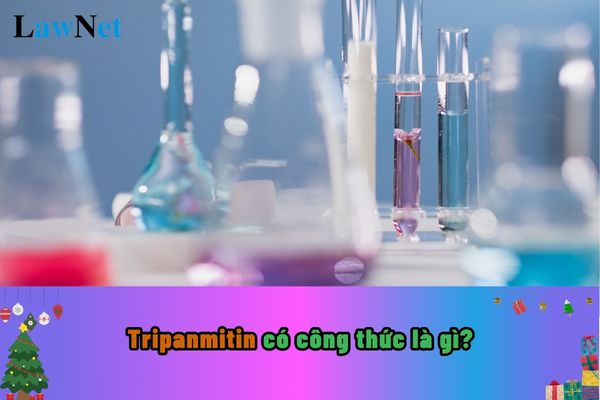What is the chemical formula of Tripalmitin? What are the assessment forms for Chemistry in Vietnam?
What is the chemical formula of Tripalmitin?
Tripalmitin is an important organic compound with numerous applications in life. Understanding the structural formula and properties of tripalmitin helps us better comprehend the role of fats in nature and their industrial applications.
|
What is the chemical formula of Tripalmitin?
|
*Note: The information on the formula of Tripalmitin in Chemistry is only for reference purposes./.

What is the chemical formula of Tripalmitin? What are the assessment forms for Chemistry in Vietnam? (Image from the Internet)
What are the assessment forms for Chemistry in Vietnam?
According to Section 7 of the Appendix for the General Education Program for Chemistry issued with Circular 32/2018/TT-BGDDT, the assessment of educational results is as follows:
- The objective of assessing educational results is to provide precise, prompt, and valuable information on how well the objectives of the program are met and on students' progress to guide learning activities, adjust teaching activities, manage and develop the curriculum, ensure each student's progress, and improve educational quality.
- The assessment is conducted based on the required criteria for quality and capacity as stipulated in the comprehensive program and the Chemistry curriculum. The scope of assessment includes all content and requirements of the Chemistry curriculum.
- Assessment forms, methods, and tools:
+ Assessment forms: Combining regular assessment, periodic assessment, and large-scale assessments at national, local, and international levels to ensure comprehensive, continuous, and integrated assessment within teaching and learning activities of both teachers and students.
+ Assessment methods and tools:
- Combining teacher assessments with self-assessment and peer assessment among students.
Coordinating assessments of situations; assessments through quizzes; assessments via projects and portfolios; assessments through feedback and reflection; and assessments through observation.
- Combining assessments of learning products (essay tests, objective multiple-choice tests, oral presentations, experimental practices, research projects,...) with assessments through observation (attitude and behavior in discussions, group work, experiments, field trips,...).
- Selecting appropriate methods and tools to assess a specific capacity.
+ To assess the cognitive chemistry component, questions (oral, written), and exercises,... may require students to present, compare, systematize knowledge, or apply knowledge to explain, demonstrate, and solve problems.
+ To assess the component of exploring the natural world from a chemical perspective, the following methods and tools can be used:
- Checklists or notes on observation results by teachers based on clear criteria about the process of experimenting and students' inquiry tasks,...
- Questions and tests aimed at assessing students' understanding of experimental skills; the ability to reason to draw consequences, verification plans, and process given data to reach conclusions; the ability to design experiments or research to perform a given learning task and propose appropriate equipment and techniques,...
- Reports on experimental results, practical work, conducting research projects,…
- To assess the component of applying learned knowledge and skills, students may be required to present practical problems needing resolution, using chemical language, tables, models, and experimental skills,… to describe, and explain the chemical phenomena in the matter being considered; using questions (requiring oral or written answers) that require students to apply knowledge, skills to solve learning problems, especially practical ones.
Thus, the assessment forms of Chemistry include combining regular assessment, periodic assessment, and large-scale assessments at national, local, and international levels to ensure comprehensive, continuous, and integrated assessment within the teaching and learning activities of both teachers and students.
Which program does the General Education Program for Chemistry in Vietnam inherit and develop from?
Under Section 2 of the General Education Program for Chemistry issued with Circular 32/2018/TT-BGDDT:
The General Education Program for Chemistry fully adheres to the regulations stated in the comprehensive program while emphasizing the following standpoints from the subject's characteristics:
[1] Ensuring inheritance and development
- The General Education Program for Chemistry inherits and enhances the strengths of the current program, absorbs the experience of constructing subject curricula from countries with advanced educational systems worldwide and in the region; meanwhile, it approaches educational achievements, and chemical sciences compatible with the cognitive level, psychology of students, considering Vietnam's economic and social conditions.
- The General Education Program for Chemistry inherits and develops educational content from the Natural Sciences subject at the lower secondary school level in a concentric structure combined with a linear structure to broaden and enhance students' knowledge and skills.
At the lower secondary level, through the Natural Sciences, students are introduced to some basic chemistry knowledge at a qualitative, visual descriptive level.
At the upper secondary level, the Chemistry subject focuses on equipping students with basic chemical knowledge about the structure, properties, and applications of elements and compounds to explain the essence of chemical changes at the necessary level.
[2] Ensuring practicality
The General Education Program for Chemistry emphasizes practicality; avoids leaning excessively on calculations; and focuses on equipping with concept tools and method usage, especially helping students develop experimental practice skills, and the ability to apply chemical knowledge to understanding and addressing some practical problems to a certain extent, meeting life requirements.
[3] Implementing career-oriented requirements
The General Education Program for Chemistry materializes career-oriented education objectives. Based on determining industry and technology processes that require intensive chemical knowledge, the curriculum selects core educational content and study topics to help students further explore chemical knowledge with many practical applications and career orientation preparation.
[4] Promoting students' activeness
The educational methods in the Chemistry subject help foster students' activeness, proactivity, and creativity to form chemical competencies and contribute to developing core competencies and qualities outlined in the comprehensive program.
Thus, the General Education Program for Chemistry inherits and develops educational content from the Natural Sciences subject at the lower secondary school level.

